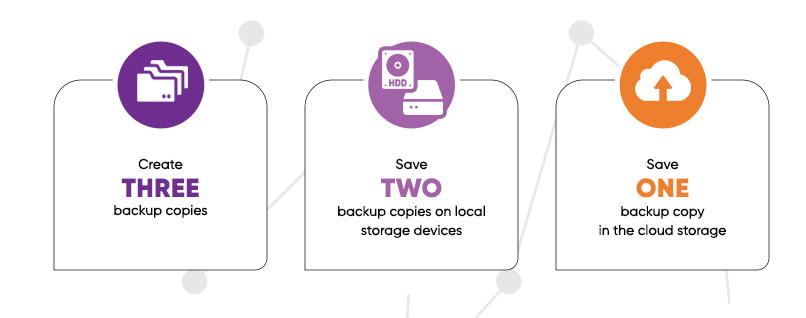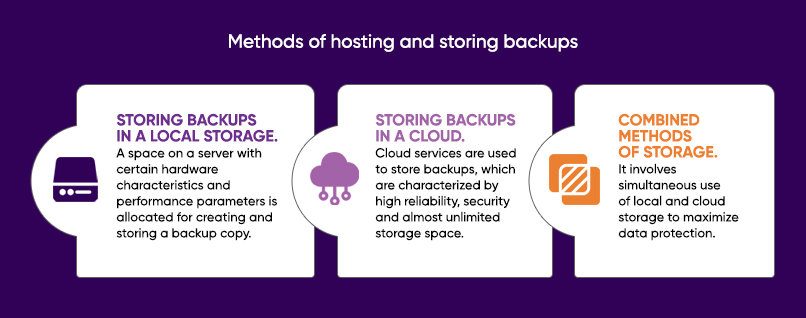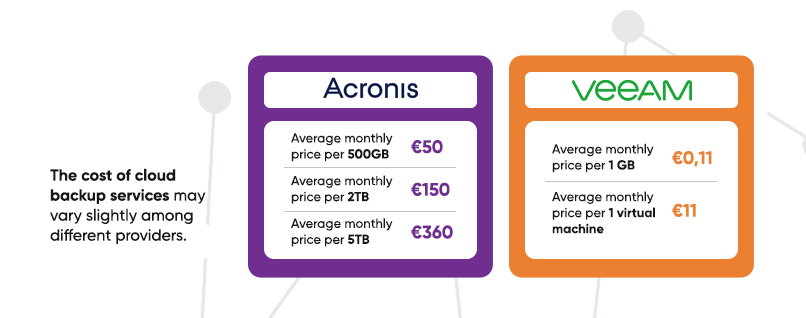Contents
- 1 Why do you need a hosted storage with a provider. Use cases
- 2 What types of data are given to the provider for backup
- 3 Methods of hosting and storing backups
- 4 What types of data are given to the provider for storing in the cloud
- 5 BaaS
- 6 How a project is prepared for launch
- 7 How to select storage hosting: criteria for selecting a provider for data storage and cloud backup
Data storage with a provider is a popular service on the European market. Individual files, databases, as well as virtual copies of databases and even servers can be stored with a provider. The most common use of this service is for storing backups. Backup providers can offer the necessary infrastructure for local hosting or their own cloud storage. You can also take advantage of BaaS (Backup as a Service), in which the service provider will assume full technical support with legal guarantees. The cost will directly depend on the selected service format, the volume of data to be backed up, and required performance level for storage and recovery systems.
Why do you need a hosted storage with a provider. Use cases
Storing data and backups is a relatively inexpensive service: even for big enterprises with large IT infrastructures storing backups (up to 5 TB) will cost less than €400 per month. On the scale of corporate expenses, this amount is most often insignificant. If the data backup process is not organized or organized carelessly, the costs can be incomparably high.

Even if IT infrastructure is well prepared, the eventual recovery process can take up to 24 hours. Otherwise, disaster recovery can take several days, and a positive outcome is not at all guaranteed. It is not difficult to calculate in your mind how much one day of downtime will cost even a small company with a staff of about 100 people. This amount will be about twenty times higher than €400.
In 2012, a Saudi oil giant fell victim to a computer virus that deleted information from hard disks. The attack forced the company's management to shut down its IT infrastructure and destroy more than 30,000 computers.
![]()
![]()
Backup storage has long been not just a recommended requirement, but an absolute necessity. A properly organized backup storage process allows you to:
- Avoid serious consequences in the event of maintenance errors and deliberate sabotage.
- Protect infrastructure from the consequences of malicious actions.
- Save data in the event of a hardware or software failure.
- Quickly recover almost any information, including individual documents.
A company can perform data backup and recovery using its own resources, but to do this it has to buy additional hardware and sometimes hire a specialist with the appropriate qualifications. It is much easier and more profitable to outsource backup data storage to a hosting service.
What types of data are given to the provider for backup
There is a common “3-2-1” backup strategy, according to which you should always make 3 backup copies: two are created on local physical media (e.g. external hard disks or SSDs) and remain in the company, and another one is transferred to the cloud and given to the provider.

This rule does not have to be followed literally: the number and format of backup copies, schedule and depth of backups can be different. Everything depends on the company’s financial capabilities and the direct need to use this or that strategy.
Both regular file archives and virtual images of servers, databases, deployed operating systems or applications are used for data recovery.
- Regular backups. In some cases, backup strategies involve not only scheduled backups, but also regular archiving of the most important files (not system images or configurations). Such archives usually remain inside the company to be used for recovery if necessary. In most cases, full-fledged backups – virtual images of systems and applications – are given to the provider for storage.
- Creating a virtual image. Most often backups are created as virtual copies containing all information and settings in the state in which the system was at the moment of backup. This allows you to quickly restore IT infrastructure in just a few clicks. At the same time, you can always set up automatic saving of virtual images on schedule, for example, every 24 hours or every few hours.
For backup and data hosting, European providers offer off-the-shelf hardware solutions and various tariffs.
Types of data backup
Different types of data backup are used to save hardware and computing resources.
- Full backup: allows you to create copies of all data, files and folders.
- Incremental backup: saves only the changes that have occurred since the previous backup.
- Differential backup: saves only the changes that have occurred since the previous full backup.
- Mirror backup: creates a replica copy. All changes to the original data are automatically reflected in the backup.
Incremental and differential backup save disk space and reduce the load on the network and computing systems. Mirror backup is the most resource-intensive type of backup and used to create fault tolerant systems.
Methods of hosting and storing backups
All backup methods can be conditionally divided into three groups according to the method of data storage:
- Storing backups in a local storage.
- Storing backups in a cloud.
- Combined methods of storage.
In the first case, a space on a server or a fully dedicated server (for example, in the company’s own office) with certain hardware characteristics and performance parameters is allocated for creating and storing a backup copy.

In the second case, cloud services are used to store backups, which are characterized by high reliability, security and almost unlimited storage space.
The combined method of storage involves simultaneous use of local and cloud storage to maximize data protection. Large European providers can offer their clients any of the service options on flexible terms.
Local storage of backups on the provider’s infrastructure (backup storage service)
If the client already uses hosting services, he can rent a storage system for backups. Backup storage on the provider’s hardware is similar to IaaS (Infrastructure as a Service) in many ways: provider offers to a client a part or dedicated infrastructure for backup and storage, disk subsystem and server space for rent (renting server space).
The hardware and its performance level are specified in advance in the agreement. At the same time, the client is responsible for the stable operation of the backup and recovery software. In some cases, the provider may assume part of the responsibilities for hardware maintenance and administration.
Local method of storage is not the most reliable one, unless the technology provides for the use of various redundant backup systems. At the same time, many companies still use local storage when, for example, it is necessary to restrict access to some important data.
![]()
![]()
Storing data and backups in the cloud (cloud backup storage service)
Storing data and backups in the cloud is the most popular method of storing backups. Cloud storage has the following important advantages:
- Increased reliability of the storage and recovery process. In local storage, there are cases when both servers fail: the primary server and the one where backups were stored. Sometimes the network connection between the servers is broken, data is sent to nowhere due to incorrect settings, or data is stored in the wrong place. Cloud storage helps a client to avoid these issues.
- There is always enough storage space. It can be difficult to predict in advance how much memory is required to store a backup. The amount of data to be backed up or the size of the backup can constantly grow, and at one point there may be not enough space on the backup server. The advantage of cloud storage is that the hosting space can be dynamically increased in size as soon as the need arises.
- Additional reliability tools. Cloud services have multiple security loops and equipped with automatic backup systems. A geographically distributed cluster allows access to data even in the event of a serious disaster at one of the provider’s data centers.
- High security of information storage. Cloud storage is administered by high-class specialists and the hardware is located in well-protected data centers in Germany, UK, USA and other countries.
Combined method of storage
To back up critical data, systems are sometimes created with double or even triple level of reliability. For example, database data is routinely backed up to object storage, database replicas are stored on dedicated servers, and full virtual backup is periodically created and updated for the entire system. The options of combined storage can be very different. The combined method is the most reliable, but also the most expensive.
What types of data are given to the provider for storing in the cloud
Cloud storage is one of the most reliable methods of storage, so it makes sense to back up your most important data to the cloud. Different types of data have specific storage and recovery requirements.
- Backup servers to the cloud. Making a full virtual copy of a server (virtual machine) is a reasonable and practical approach. However, it should be noted that not all applications can work correctly after recovery. For this reason, it makes sense to create separate backups for documents, databases, and even settings.
- Backup databases to the cloud. It is mandatory to make separate backups for databases, because after the virtual machine is restored, the data in the database may not be consistent, i.e. the database will be inconsistent.
- Backup data from servers to the cloud. Continuous document workflow is critical for some organizations. Restoring one or more files from a virtual machine or database backup can be very time-consuming, so it always makes sense to back up the most needed documents.
- Backup settings to the cloud. Uploading data to new hardware is only half of the recovery process. It can take just as long to set up a server or operating system. You can save time with a pre-arranged settings backup.
BaaS
Backup as a Service (BaaS) is a form of service in which the provider takes responsibility for backing up and restoring data of the client’s IT infrastructure. The service provider hosts the backups in his own cloud storage and becomes responsible for administration, hardware operation and security. Payment is most often made on a Pay As You Go basis, meaning that the client pays only for the resources he uses to maintain the backups. There are many obvious advantages to this form of cooperation:
- Backup from any source. The source of data for backing up can be any media: the client’s own server, storage in a data center, any cloud service, including public ones.
- Backup of any data. Large European providers have the capacity to host any amount of data regardless of its format and volume. (Serverspace cloud for backup)
- Security of backup. Availability, stability and security of cloud backup are guaranteed by the provider through SLAs, often with financial guarantees.
- Service management via a convenient WEB-application. The client can selects which backups he needs to store, customize recovery settings and control costs using a regular web application.
The client can select the frequency of backup and the speed of data recovery. These technical parameters are negotiated in a legal agreement with the provider (SLA).
The main parameters of the backup settings are:
- RPO (Recovery Point Objective): the point in time at which data will be restored.
- RTO (Recovery Time Objective): the amount of time to recover from the backup.
The process of creating backups is automated: the system itself defines servers and computers in the network, objects in the Active Directory database. You can create a backup for:
- Data and files of any format
- Databases
- Any operating systems (Windows, Linux, Mac OS, etc.)
- Physical machines
- Virtual machines
When making a choice in favor of BaaS service, you should take into account the level of operating costs. These are easy to calculate, as service providers often charge for storage volumes in gigabytes. In the long term, this method of backup storage may be less profitable than the classic method of storing backups on the provider’s infrastructure. For the same reason, many companies select BaaS as a temporary solution.
How a project is prepared for launch
- The client tells the service provider the required storage volume and specifies the type of data to be stored.
- The provider offers to the client several solutions depending on the options of the software used, makes an expert assessment and gives recommendations already at the audit stage.
- The client pays a fixed license fee for the software used and a variable amount for the volumes used.
For data migration, providers offer clients reliable and well-proven software solutions for data migration (Data backup solutions), virtual machine creation and server migration (Server backup solutions) from the world’s leading manufacturers. The package price includes the license fee for using the product and data storage capacity. In most cases, providers offer off-the-shelf solutions with a certain price for a certain amount of storage per month The cost of cloud backup services (cloud server space cost) may vary slightly among different providers.
| Provider | Average monthly price per 500GB | Average monthly price per 2TB | Average monthly price per 5TB |
| Acronis | €50 | €150 | €360 |
| Provider | Average monthly price per 1 GB | Average monthly price per 1 virtual machine |
| Veeam | €0,11 | €11 |

How to select storage hosting: criteria for selecting a provider for data storage and cloud backup
When selecting a service and service provider, you should pay attention to a number of important criteria that will help you better assess the quality of future service. By default, Tier 3 data centers provide the following:
- Secure storage and transfer of data
- Compliance with legal regulations and industry standards
- Server and system uptime of at least 99.9%
For his part, the client should pay attention to the technical parameters of its own IT infrastructure.
- Channel width. If the transmission channel is too narrow, the backup speed may be too slow, and the provider may not always be able to provide faster traffic
- The speed of the server’s disk subsystem. If the disk subsystem proves to be too slow, this can also directly affect the data transfer speed.
- Correct operation of the connector (agent operation). The agent programs, necessary for reading the data, do not always work correctly. Before creating a full copy, it is better to test it by creating a backup for some part of the data to make sure that the software works correctly.
- Considering data growth forecast. The amount of data is constantly accumulating. This must be taken into account when storing backups.
- Considering backup plan. In most cases backup plan involves creating and storing a certain number of backups. It is necessary to consider the backup schedule and the total amount of storage capacity required, taking into account the tariff.
The quality of the support service is of great importance. The nature of the interaction can be judged already at the initial contact. Support staff should show real interest in solving the client’s problem, rather than offering only standard solutions provided by instructions.
Storage hosting and data backup services: solutions and providers
Write us a message to get additional information.
or book a free consultation
To save you time, we have specifically studied offers from the biggest European providers. You can download a checklist with this information here.
Article author Olga Boujanova Consultant on hosting solutions, network and cloud technologies